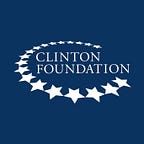3 things you can do today to help prevent opioid overdose
EDITOR’S NOTE: Since this piece was posted, overdose deaths have risen significantly during the COVID-19 pandemic — with 88,000 overdose deaths in the 12 months ending August 2020. The Clinton Foundation’s Opioid Response Network has also scaled up during this period, distributing over 150,000 doses to recovery residences across the country.
The opioid crisis is a critical issue that is tragically affecting every community across the United States. Preliminary data shows that in 2018 alone, there were over 68,000 overdose-related deaths, two-thirds of which involved opioids. The visibility of this epidemic is manifested in the family, friends, neighbors, and other loved ones who have been lost.
One of the ways the Clinton Foundation’s Opioid Response Network fights the epidemic is by expanding access to naloxone, the medication that reverses the physical effects of an opioid overdose. To date, the Foundation has distributed more than 13,000 doses of naloxone across the country. Increasing access to this life-saving medication and the number of people who know how to use it will reduce the number of overdose deaths, year by year and day by day.
Solving this crisis will require a long-term comprehensive reform of our existing health and pharmaceutical systems, but there are steps you can take to save lives now. We can all educate ourselves and be prepared to act in emergencies to save someone’s life.
Here are three things that you can do today to help prevent overdoses.
1. Properly store and dispose of medications
The first step to preventing an overdose is securing your prescriptions the same way you would other valuables in your home. Removing these medications from common, easy-to-access areas keeps loved ones safe from an accidental overdose. If possible, keep all medicine in an area that only you know about or securely locked away. Many homes end up with unwanted or expired prescription and over-the-counter medications that can lead to accidental poisoning, misuse, and overdose.
For unwanted or expired medications, the best solution is to dispose of them safely. Many pharmacies have anonymous, on-site drug disposal boxes for free disposal of unwanted medicines. Find a drug disposal location in your neighborhood or participate in the next National Drug Take Back Day to reduce the amount of potentially harmful medication in your community.
Watch a video to see Drug Take-Back Day in action with the Clinton Foundation and the faith partners we work with.
If no prescription drug take-back program is available in your area, then follow these simple steps to throw the drugs in the household trash:
- Remove the medicine from its original container and mix it with an undesirable substance, such as used coffee grounds or kitty litter.
- Place the mixture in a sealable bag, empty bag, or other containers to prevent medications from leaking or breaking out of a garbage bag.
2. Know the signs and symptoms of an overdose
Many overdose deaths may be prevented with quick medical intervention and recognizing the signs of an opioid overdose enables you to act. If there is a concern that someone is experiencing an overdose, call 911 immediately. There are some general indicators that a person may be experiencing this potentially life-threatening occurrence. Below are some common signs of an opioid overdose, with a full list found here.
Read more information on how to act quickly.
3. Carry naloxone
One of the most effective and powerful measures we can all take is to carry naloxone wherever we go. Naloxone is an overdose reversal drug and can be obtained without a prescription in many states. NARCAN, the intranasal version of naloxone, is easy to administer without any medical training. Opioid overdoses can turn fatal quickly due to complications arising in the respiratory systems, making one’s breath shallow or even stopping it altogether. At this point, using every second becomes crucial to saving a person’s life. In the event of an overdose, having naloxone on hand can be the difference between life and death.
Knowing where to find it and how to administer it are two important steps. In many states, no prescription is required to obtain naloxone at your local pharmacy and a recent public health advisory urged more Americans to carry naloxone. Many organizations also offer free training on how to administer naloxone.
With a topic as complex and multilayered as the opioid crisis, being well informed can make a significant difference. Knowing the most up-to-date information about opioid overdoses and proper treatment can prepare you to take action when it’s most needed. Once you have this critical information for yourself, share it with your community and beyond. For more information on the Foundation’s work to address the opioid epidemic, visit www.clintonfoundation.org/hope.
